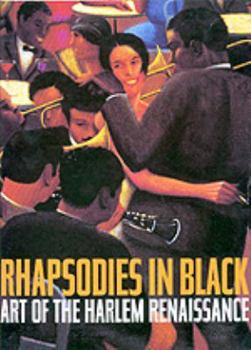Rhapsodies in Black: Art of the Harlem Renaissance
Select Format
Select Condition 
Book Overview
Harlem has captivated the imagination of writers, artists, intellectuals, and politicians around the world since the early decades of this century. Rhapsodies in Black: Art of the Harlem Renaissance examines the cultural reawakening of Harlem in the 1920s and 1930s as a key moment in twentieth-century art history, one that transcended regional and racial boundaries. Published to coincide with the exhibition that opens in England and travels to the United States, this catalog reflects the Harlem Renaissance's impressive range of art forms--literature, music, dance, theater, painting, sculpture, photography, film, and graphic design. The participants included not only artists based in New York, but also those from other parts of the United States, the Caribbean, and Europe.
Richard J. Powell and David A. Bailey present selected works that focus on six themes: Representing "The New Negro;" Another Modernism; Blues, Jazz, and the Performative Paradigm; The Cult of the Primitive; Africa: Inheritance and Seizure; and Jacob Lawrence's Toussaint L'Ouverture series. The visual arts from 1919 to 1938 included in the book suggest the extraordinary vibrancy of the time when Harlem was a metaphor for modernity. In spite of the importance of the Harlem Renaissance to early twentieth-century American culture and to the artistic climate of "Jazz Age" Paris and Weimar Berlin, few art exhibitions have been devoted exclusively to the subject. Rhapsodies in Black will be welcomed for its unique presentation of this creative time.
Richard J. Powell and David A. Bailey present selected works that focus on six themes: Representing "The New Negro;" Another Modernism; Blues, Jazz, and the Performative Paradigm; The Cult of the Primitive; Africa: Inheritance and Seizure; and Jacob Lawrence's Toussaint L'Ouverture series. The visual arts from 1919 to 1938 included in the book suggest the extraordinary vibrancy of the time when Harlem was a metaphor for modernity. In spite of the importance of the Harlem Renaissance to early twentieth-century American culture and to the artistic climate of "Jazz Age" Paris and Weimar Berlin, few art exhibitions have been devoted exclusively to the subject. Rhapsodies in Black will be welcomed for its unique presentation of this creative time.
Format:Paperback
Language:English
ISBN:0520212681
ISBN13:9780520212688
Release Date:September 1997
Publisher:University of California Press
Length:192 Pages
Weight:2.40 lbs.
Dimensions:13.5" x 0.8" x 11.0"
Customer Reviews
2 ratings
Satisfied customer
Published by Thriftbooks.com User , 15 years ago
This book i ordered came within two days of my order and it was not torn nor were its pages written on.
expanding the scope of a central moment in modern art
Published by Thriftbooks.com User , 27 years ago
This book provides those who are more likely to have believed the Harlem Renaissance to be entirely literary and entirely Harlem-centered with evidence of the all-encompassing scope and international import of this crucial, modern, blackened artistic surge. The exploration of black identity and construction of black nationality called the Harlem Renaissance is insightfully revisited through the social and artistic problems enacted in the works, within the voices, and upon the bodies of protagonists: Josephine Baker, Paul Robeson, and surprisingly, Orson Welles. This book is a fine complement to books which focus on literary-hitsorical aspects (such as David L. Lewis' _When Harlem was in Vogue_) and those which focus on music such as Angela Davis' _Blues Legacies and Black Feminism_ and Albert Murray's _Stomping the Blues_). It is a a fabulous expansion of the artistic territory encompassed in black art. Maya Angleou has said: "I am human, and therefore nothing h! uman can escape my grasp." I believe that black art has languished too long in the storage bin where fads and fanices go to die. _Black Rhapsodies_ rescues the Renaissance from this fate by positing black art as a philosphical stance, therefore attainable in varied ways throughout the post WWI world--not as the exotic and undisciplined, irregular expressions of primitive black jungle souls on the drum-pulsing streets of 20s Harlem. I couldn't agree more, and I hope that the idea that black art is both a real category and a complex one full of contadictions is adopted in the teaching of the Renaissance.My one complaint is minor and may stem from my own unfamiliarity with the indexing system of books on art. I found it difficult to locate quickly the visual art being described in certain passages. If there were a more convenient way on idexing the art or of expaining the system to the novice reader, it would be appreciated.






